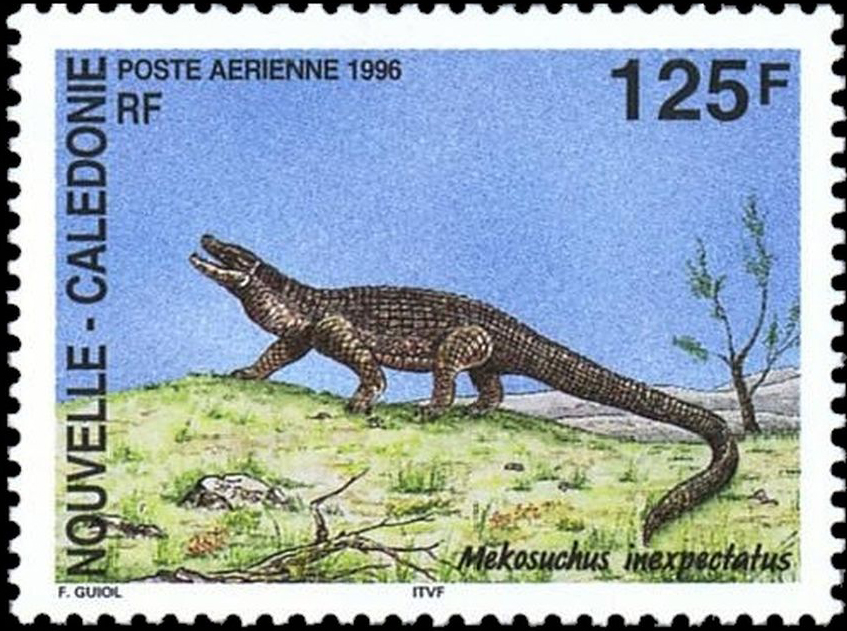Mekosuchus inexpactatus Balouet & Buffetaut, 1987

(Da: it.wikipedia.org)
Phylum: Chordata Haeckel, 1874
Subphylum: Vertebrata Cuvier, 1812
Classe: Reptilia Laurenti, 1768
Ordine: Crocodilia Owen, 1842
Famiglia: Crocodylidae Cuvier, 1807
Genere: Mekosuchus Balouet & Buffetaut, 1987
Specie e sottospecie
Attualmente ci sono quattro specie di Mekosuchus riconosciuti. La prima scoperta (e più giovane) è la specie tipo Mekosuchus inexpectatus dell’Olocene nella Nuova Caledonia, che si estinse a un certo punto nel corso degli ultimi 4.000 anni (con l'arrivo dell'uomo). I suoli poveri della Nuova Caledonia limitavano le grandi prede terrestri, così il Mekosuchus aveva dei denti posteriori specializzati per rompere i gusci di molluschi. È nota un'altra specie nell’Olocene il M. kalpokasi che viveva sull'isola di Efate, Vanuatu circa 3000 anni fa (anche questa pare sia scomparsa con l'arrivo dell'uomo). Il M. whitehunterensis , la più antica specie conosciuta, vissuto durante il tardo Oligocene nel Queensland. Il Mekosuchus sanderi vissuto anche nel Queensland, ma in seguito, durante il Miocene.
Descrizione
Si crede che la specie si sia estinta con l'arrivo dell'uomo sulle isole del Sud Pacifico isole dove vivevano. Erano coccodrilli di piccole dimensioni circa 2 metri, molto più terrestri che acquatici.
Diffusione
Sopravvisse fino all'Olocene, e le loro sub-fossili sono stati trovati in Nuova Caledonia e Vanuatu.
Bibliografia
–Balouet, J.C. (1991). "The fossil vertebrate record of New Caledonia". In Vickers-Rich, P.; Monaghan, J.M.; Baird, R.F.; Rich, T.H. (eds.). Vertebrate Palaeontology of Australasia. Monash University Publications Committee, Melbourne, Australia. pp. 1381-1409.
–Balouet, J.; Buffetaut, E. (1987). "Mekosuchus inexpectatus, n. Gen., n. Sp., crocodilien nouveau de l'Holocene de Nouvelle Calédonie". Comptes Rendus de l'Académie des Sciences de Paris. 2 (304): 853-856.
–Willis, P. M. A. (1997). "Review of fossil crocodilians from Australasia". Australian Zoologist. 30 (3): 287-298.
–Willis, P.M.A. (1997). "New crocodilians from the late Oligocene White Hunter Site, Riversleigh, northwestern Queensland". Memoirs of the Queensland Museum. 41: 423–438.
–Willis, P. M. A. (2001). "New crocodilian material from the Miocene of Riversleigh (northwestern Queensland, Australia)". Crocodilian biology and evolution. Surrey Beatty & Sons.
–Mead, Jim I; Steadman, David W; Bedford, Stuart H; Bell, Christopher J; Spriggs, Matthew (2002). "New Extinct Mekosuchine Crocodile from Vanuatu, South Pacific" (PDF). Copeia. 2 (3): 632.
–Holt, T.R.; Salisbury, S.W.; Worthy, T.; Sand, C.; Anderson, A. (2007). New material of Mekosuchus inexpectatus (Crocodylia: Mekosuchinae) from the Quaternary of New Caledonia. 11th Conference on Australian Vertebrate Evolution, Palaeontology and Systematics. Melbourne, Australia.
–Stein, M.; Yates, A.M.; Scanlon, J.D.; Archer, M.; Willis, P.M.A.; Salisbury, S.; Hand, S.J. (2013). New materials of Oligo–Miocene Mekosuchus from the Riversleigh World Heritage Area indicate unusual development and palaeoecology. Proceedings of the 14th Conference on Australasian Vertebrate Evolution, Palaeontology & Systematics. Vol. 79.
–Scanlon, J.D. (2014). "Giant terrestrial reptilian carnivores of Cenozoic Australia.". Carnivores of Australia: past, present and future. CSIRO Publishing.
–Stein, M.; Archer, M.; Hand, S.J. (2016). "Dwarfism and feeding behaviours in Oligo-Miocene crocodiles from Riversleigh, northwestern Queensland, Australia". Acta Palaeontologica Polonica. 61 (1): 135-142.
–Anderson, Atholl; Sand, C; Petchey, F; Worthy, T. H (2010). "Faunal extinction and human habitation in New Caledonia: Initial results and implications of new research at the Pindai Caves". Journal of Pacific Archaeology. 1 (1).
–Ristevski, J.; Willis, P.M.A.; Yates, A.M.; White, M.A.; Hart, L.J.; Stein, M.D.; Price, G.J.; Salisbury, S.W. (2023). "Migrations, diversifications and extinctions: the evolutionary history of crocodyliforms in Australasia". Alcheringa: An Australasian Journal of Palaeontology. 47 (4): 370-415.
–Brochu, C.A. (2001). "Crocodylian snouts in space and time: phylogenetic approaches toward adaptive radiation". American Zoologist. 41 (3): 564-585.
–Michael S. Y. Lee; Adam M. Yates (27 June 2018). "Tip-dating and homoplasy: reconciling the shallow molecular divergences of modern gharials with their long fossil". Proceedings of the Royal Society B. 285 (1881).
–Yates, A.M.; Stein, M. (2024). "A reinterpretation and taxonomic revision of Ultrastenos willisi Stein, Hand and Archer, 2016, a short-snouted mekosuchine crocodylian from the Oligocene of northern Australia". Palaeontologia Electronica. 27 (1).
–Darren Naish, "Tetrapod Zoology": "The small, recently extinct, island-dwelling crocodilians of the south Pacific", 2006.
–Stein, M.D.; Hand, S.J.; Archer, M.; Wroe, S.; Wilson, L.A.B. (2020). "Quantitatively assessing mekosuchine crocodile locomotion by geometric morphometric and finite element analysis of the forelimb". PeerJ. 8: e9349.

|
Data: 23/02/1996
Emissione: Animali preistorici Stato: New Caledonia |
|---|